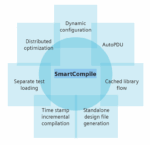In the race to deliver ever-larger SoCs under shrinking schedules, simulation is becoming a bottleneck. With debug cycles constrained by long iteration times—even for minor code changes—teams are finding traditional flows too rigid and slow. The problem is further magnified in continuous integration and continuous deployment… Read More
Siemens EDA Unveils Groundbreaking Tools to Simplify 3D IC Design and Analysis
In a major announcement at the 2025 Design Automation Conference (DAC), Siemens EDA introduced a significant expansion to its electronic design automation (EDA) portfolio, aimed at transforming how engineers design, validate, and manage the complexity of next-generation three-dimensional integrated circuits (3D ICs).… Read More
Jitter: The Overlooked PDN Quality Metric
Bruce Caryl is a Product Specialist with Siemens EDA
The most common way to evaluate a power distribution network is to look at its impedance over the effective frequency range. A lower impedance will produce less noise when transient current is demanded by the IC output buffers. However, this transient current needs to be provided… Read More
DAC News – A New Era of Electronic Design Begins with Siemens EDA AI
AI is the centerpiece of DAC this year. How to design chips to bring AI algorithms to life, how to prevent AI from hacking those chips, and of course how to use AI to design AI chips. In this latter category, there were many presentations, product announcements and demonstrations. I was impressed by many of them. But an important observation… Read More
Podcast EP293: 3DIC Progress and What’s Coming at DAC with Dr. John Ferguson and Kevin Rinebold of Siemens EDA
Dan is joined by Dr. John Ferguson, Director of Product Management for the Calibre nmDRC and 3DIC related products for Siemens EDA. John has worked extensively in the area of physical design verification. Holding several patents, he is also a frequent author in the physical design and verification domain. Current activities … Read More
The Siemens Questa plus AI Story Gathers Momentum
I wrote recently about a Siemens pre-announcement at DVCon on their directions in simulation+AI. On May 13th they officially announced a full spectrum of capabilities under the brand Questa One. Abhi Kolpekwar (VP/GM at Siemens EDA) more fully fleshed out the story for me. I asked why Siemens is late to this simulation+AI party.… Read More
Siemens EDA Outlines Strategic Direction for an AI-Powered, Software-Defined, Silicon-Enabled Future
In a keynote delivered at this year’s Siemens EDA User2User event, CEO Mike Ellow presented a focused vision for the evolving role of electronic design automation (EDA) within the broader context of global technology shifts. The session covered Siemens EDA’s current trajectory, market strategy, and the changing landscape … Read More
EDA AI agents will come in three waves and usher us into the next era of electronic design
Author: Niranjan Sitapure, AI Product Manager, Siemens EDA
We are at a pivotal point in Electronic Design Automation (EDA), as the semiconductors and PCB systems that underpin critical technologies, such as AI, 5G, autonomous systems, and edge computing, grow increasingly complex. The traditional EDA workflow, which includes… Read More
Safeguard power domain compatibility by finding missing level shifters
In the realm of mixed signal design for integrated circuits (ICs), level shifters play a critical role for interfacing circuits that operate at different voltage levels. A level shifter converts signal from one voltage level to another, ensuring compatibility between components. Figure 1 illustrates a missing level shifter… Read More
Metal fill extraction: Breaking the speed-accuracy tradeoff
As semiconductor technology scales and device complexity increases, accurately modeling the parasitic effects of metal fill has become critical for circuit performance, power integrity, and reliability. Metal fill is a crucial part of the manufacturing process, ensuring uniform layer density, improving planarization,… Read More









